Magical Maha Maya - Epic Dimensions in Buddhist Art
Magical Maha Maya - Epic Dimensions in Buddhist Art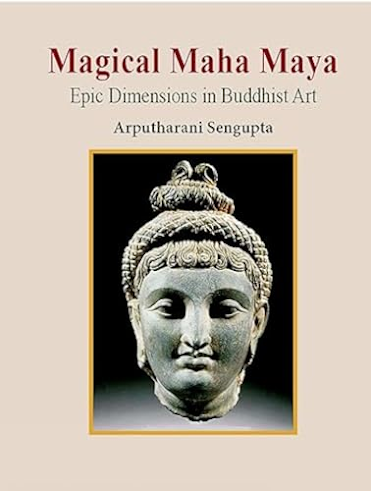
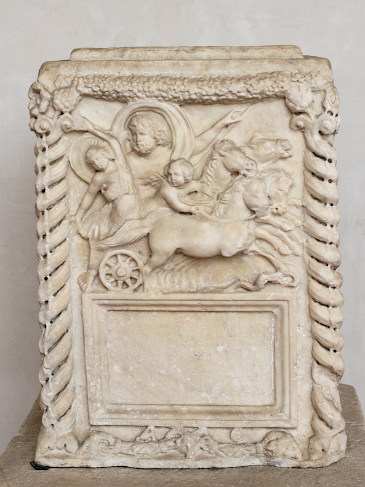 Pluto abducting Proserpina (Persephone), Cinerary altar with a tabula without inscription, Marble, Bathsof Diocletian, Rome, 2nd century CE (Antonine Age 138-180 CE), National Roman Museum, Italy.Proserpina kidnapped Kircheriano Terme.jpg
Pluto abducting Proserpina (Persephone), Cinerary altar with a tabula without inscription, Marble, Bathsof Diocletian, Rome, 2nd century CE (Antonine Age 138-180 CE), National Roman Museum, Italy.Proserpina kidnapped Kircheriano Terme.jpg
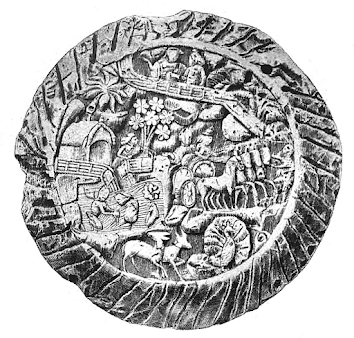 Ashram of sage Kanva depicted on terracotta plaque, 2nd century BCE3.1 Shakuntala medallion, Two-sided terracotta disc, Ã 7.7 cm, Bhita, India, 1st-2nd century CEKolkata: Indian Museum, Kolkata (N.S.2297)
Ashram of sage Kanva depicted on terracotta plaque, 2nd century BCE3.1 Shakuntala medallion, Two-sided terracotta disc, Ã 7.7 cm, Bhita, India, 1st-2nd century CEKolkata: Indian Museum, Kolkata (N.S.2297)
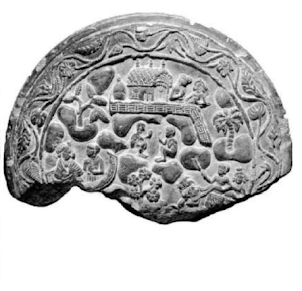 3.2 Heavenly Arcadia stone-disc, Gandhara, Lahore, Private collection, 2nd century CE(After Bopearachchi)
3.2 Heavenly Arcadia stone-disc, Gandhara, Lahore, Private collection, 2nd century CE(After Bopearachchi)
To begin with, a terracotta pendant from Bhita near Allahabad depicts a sylvan glade in which the relentless Hades forcibly carries off Persephone in a four-horse chariot. The tiny detail correlates with Plutoâs abduction carved on a 2nd-century Roman cinerary altar.1 At the doorway to the Chaitya-Griha next to a bouquet of six flowers with six-petals earth-mother goddess dashes after the chariot. The peacock and deer close to a lotus pond laud the sacred abode of Maha Vihara Maya Devi worshiped as Lakshmi. At the distant horizon a couple appears behind the fenced-in sanctuary conceived as the home of the blessed after death (3.1). A corresponding stone-disc with miraculous trees encircled by meandering lotus pool is where the souls find a final resting place. In the lower right of the fragment from Gandhara is the couple in a horse-drawn chariot. In the transient art of Perpetual Limbo the heroic and the untainted float in the clouds, and where the cloud ends the divine couple converse by the fenced-in wagon-vaulted Chaitya-Vihara.2 The crowning touch to the barrel roof is a row of Purna-Kalash finials denoting the abode of gods and goddesses (3.2). The dream vision of a Pure Land Elysium carved on the stonedisc from Gandhara is similar to the pictorial relief of Arcadia stamped on both sides of the Bhita terracotta disc just 7.7 cm in diameter. The small stone-disc and the mold for the superfine Bhita medallion were doubtlessly made by an ivory carver or gem engraver.The repetition of everlasting Pure Land indicates that the sculptors had access to pattern books managed by a Sutradhar. The unique Greco-Buddhist ex-votos are strikingly similar to the much larger Greek marble oscillum discs typically suspended in a temple colonnade or from a tree.
ÎÏ Î±ÏÏίÏÎ¿Ï Î¼Îµ με Îνα Ïήλινο κÏεμαÏÏÏ ÎºÏÏμημα αÏÏ Ïην Bhita ÏληÏίον ÏÎ¿Ï Allahabad Ïο οÏοίο αÏεικονίζει Îνα δαÏÎ¹ÎºÏ Î¾ÎÏÏÏο ÏÏÎ¿Ï Î¿ Î±Î´Ï ÏÏÏηÏÎ¿Ï ÎÎ´Î·Ï Î±ÏÏάζει βίαια Ïην ΠεÏÏεÏÏνη με Îνα άÏμα ÏεÏÏάÏÏν αλÏγÏν. ΠμικÏοÏκοÏική λεÏÏομÎÏεια ÏÏ ÏÏεÏίζεÏαι με Ïην αÏαγÏγή ÏÎ¿Ï Î Î»Î¿ÏÏÏνα, ÏκαλιÏμÎνη Ïε Îνα ÏÏμαÏÎºÏ ÏεÏÏοδÏÏο βÏÎ¼Ï ÏÎ¿Ï 2Î¿Ï Î±Î¹Ïνα.1 ΣÏην ÏÏÏÏα ÏÎ¿Ï Chaitya-Griha, δίÏλα Ïε Îνα μÏÎ¿Ï ÎºÎÏο αÏÏ Îξι Î»Î¿Ï Î»Î¿Ïδια με Îξι ÏÎÏαλα, η θεά ÏÎ·Ï Î³Î·Ï-μηÏÎÏÎ±Ï ÏÏÎÏει ÏίÏÏ Î±ÏÏ Ïο άÏμα. Το ÏαγÏνι και Ïο ελάÏι κονÏά Ïε μια λίμνη με λÏÏÏ Î´Î¿Î¾Î¬Î¶Î¿Ï Î½ Ïην ιεÏή καÏοικία ÏÎ·Ï Maha Vihara Maya Devi, ÏÎ¿Ï Î»Î±ÏÏÎµÏ ÏÏαν ÏÏ Lakshmi. ΣÏον μακÏÎ¹Î½Ï Î¿ÏίζονÏα, Îνα Î¶ÎµÏ Î³Î¬Ïι εμÏανίζεÏαι ÏίÏÏ Î±ÏÏ Ïο ÏεÏιÏÏαγμÎνο ιεÏÏ, ÏÎ¿Ï Î¸ÎµÏÏείÏαι ÏÏ Ïο ÏÏίÏι ÏÏν ÎµÏ Î»Î¿Î³Î·Î¼ÎνÏν μεÏά θάναÏον (3.1). ÎÎ½Î±Ï Î±Î½ÏίÏÏοιÏÎ¿Ï Î»Î¯Î¸Î¹Î½Î¿Ï Î´Î¯ÏÎºÎ¿Ï Î¼Îµ Î¸Î±Ï Î¼Î±ÏÎ¿Ï Ïγά δÎνÏÏα, ÏεÏιÏÏÎ¹Î³Ï ÏιÏμÎÎ½Î¿Ï Î±ÏÏ ÎµÎ»Î¹ÎºÎ¿ÎµÎ¹Î´Î® λίμνη με λÏÏÏ, είναι Ïο Ïημείο ÏÏÎ¿Ï Î¿Î¹ ÏÏ ÏÎÏ Î²ÏίÏÎºÎ¿Ï Î½ Ïην Ïελική καÏοικία. ÎάÏÏ Î´ÎµÎ¾Î¹Î¬ ÏÏο θÏαÏÏμα αÏÏ Ïην Gandhara ÏαÏÎ¿Ï ÏιάζεÏαι Ïο Î¶ÎµÏ Î³Î¬Ïι Ïε Îνα ιÏÏήλαÏο άÏμα. ΣÏην μεÏαβαÏική ÏÎÏνη ÏÎ¿Ï Perpetual Limbo[1], Ïο ηÏÏÎ¹ÎºÏ ÎºÎ±Î¹ Ïο αμÏÎ»Ï Î½Ïο εÏιÏλÎÎ¿Ï Î½ ÏÏα ÏÏννεÏα, και εκεί ÏÎ¿Ï ÏελειÏνει Ïο ÏÏννεÏο, Ïο θεÏÎºÏ Î¶ÎµÏ Î³Î¬Ïι ÏÏ Î½Î¿Î¼Î¹Î»ÎµÎ¯ δίÏλα ÏÏην ÏεÏιÏÏαγμÎνη, θολÏÏή Chaitya-Vihara.2 ΠκοÏÏ Ïαία Ïινελιά ÏÏην οÏοÏή Ïε ÏÏήμα βαÏÎµÎ»Î¹Î¿Ï ÎµÎ¯Î½Î±Î¹ μια ÏειÏά αÏÏ Î±ÏÎ¿Î»Î®Î¾ÎµÎ¹Ï Purna-Kalash[2] ÏÎ¿Ï Ï ÏοδηλÏÎ½Î¿Ï Î½ Ïην καÏοικία θεÏν και θεαινÏν (3.2). Το ονειÏÎ¹ÎºÏ ÏÏαμα ενÏÏ ÎÎ»Ï ÏÎ¯Î¿Ï ÏÎ·Ï ÎÎ³Î½Î®Ï ÎηÏ, ÏκαλιÏμÎνο ÏÏον λίθινο δίÏκο αÏÏ Ïην Gandhara, είναι ÏαÏÏμοιο με Ïο εικονογÏαÏÎ¹ÎºÏ Î±Î½Î¬Î³Î»Ï Ïο ÏÎ·Ï Arcadia, ÏÎ¿Ï ÎµÎ¯Î½Î±Î¹ ÏÏÏαγιÏμÎνο και ÏÏÎ¹Ï Î´Ïο ÏÎ»ÎµÏ ÏÎÏ ÏÎ¿Ï Î´Î¯ÏÎºÎ¿Ï Î±ÏÏ ÏεÏακÏÏα ÏÎ·Ï Bhita, διαμÎÏÏÎ¿Ï Î¼ÏÎ»Î¹Ï 7,7 εκαÏοÏÏÏν. ΠμικÏÏÏ ÏÎÏÏÎ¹Î½Î¿Ï Î´Î¯ÏÎºÎ¿Ï ÎºÎ±Î¹ Ïο καλοÏÏι για Ïο εξαιÏεÏικά λεÏÏÏ Î¼ÎµÏάλλιο ÏÎ·Ï Bhita αναμÏίβολα καÏαÏÎºÎµÏ Î¬ÏÏηκαν αÏÏ Îναν γλÏÏÏη ελεÏανÏÏδονÏÎ¿Ï Î® ÏαÏάκÏη ÏολÏÏιμÏν λίθÏν.
ΠεÏανάληÏη ÏÎ·Ï Î±Î¹ÏÎ½Î¹Î±Ï ÎÎ³Î½Î®Ï ÎÎ·Ï Ï ÏοδηλÏνει ÏÏι οι γλÏÏÏÎµÏ ÎµÎ¯Ïαν ÏÏÏÏβαÏη Ïε βιβλία μοÏίβÏν ÏÎ¿Ï Î´Î¹Î±ÏειÏιζÏÏαν ÎÎ½Î±Ï Sutradhar[3]. Τα μοναδικά ÎµÎ»Î»Î·Î½Î¿Î²Î¿Ï Î´Î¹ÏÏικά αναθήμαÏα είναι ενÏÏ ÏÏÏιακά ÏαÏÏμοια με ÏÎ¿Ï Ï ÏÎ¿Î»Ï Î¼ÎµÎ³Î±Î»ÏÏεÏÎ¿Ï Ï ÎµÎ»Î»Î·Î½Î¹ÎºÎ¿ÏÏ Î¼Î±ÏμάÏÎ¹Î½Î¿Ï Ï Î´Î¯ÏÎºÎ¿Ï Ï ÏαλανÏÏÏεÏν[4] ÏÎ¿Ï ÏÏ Î½Î®Î¸ÏÏ Î±Î¹ÏÏοÏνÏαι ανηÏÏημÎνοι Ïε μια κιονοÏÏοιÏία Î½Î±Î¿Ï Î® αÏÏ Îνα δÎνÏÏο.
The Kattahari JatakamIn patriotic archaeology, the superb vision of Arcadia captured in the votive discs is eagerly taken up as the âSign of Shakuntalaâ from Kalidasaâs Abhijnana-Sakuntala, a Sanskrit classic play of the early Gupta period. The signet ring as a âSign of Acknowledgmentâ is critical to the love story of Shakuntala brought up in a secluded hermitage.3 Brahmadatta the King of Banaras rode into the woodlands on his chariot and came upon Shakuntala. A dream conception came about in their brief embrace.Brahmadatta departed saying, âIf it is a girl let my signet ring nurture the child, if not bring the boy and the ring back to me.â Shakuntala took the boy to meet his father but on the way, the ring slid into a river and the king could not recognize Shakuntala without the ring. The same story in the Buddhist Kattahari Jatakam translated by E. B. Cowell tells that when the King of Banaras embraced the damsel the Bodhisattva entered her womb like the bolts of Indra. But without the keepsake signet ring, the King of Banaras would not acknowledge his son. To establish her sonâs birthright, the mother swung the child and chucked him up into the air declaring that he would fall and die if he is not the kingâs [...] son. The toddler sat cross-legged in space, then descended to sit on the lap of his father the king. Later, the Bodhisattva ruled Banaras as the renowned Katthawahna bearer.
 Daniel Chester French's "Abraham Lincoln" prominently depicts fasces on the ends of the armrests. (NPS)[5]
Daniel Chester French's "Abraham Lincoln" prominently depicts fasces on the ends of the armrests. (NPS)[5]
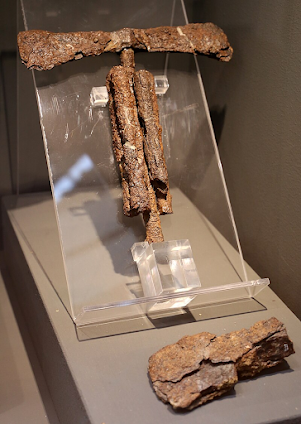 Earliest depiction of a fasces, c. 610 BC, discovered as a grave good in Vetulonia in 1897[7]
Earliest depiction of a fasces, c. 610 BC, discovered as a grave good in Vetulonia in 1897[7]
Kattha means a bundle of sticks or rods in Sanskrit. A bundle of rods bound together around an ax with the blade projecting called fasces heralded magistral power in ancient Rome. The emblem of authority might also indicate the Avestan barez, the baresman bundle linked to Haoma performed for strength, good health, and undying spirit. Zoroastrian baresman bundle carried by Persian Magi is attested by Strabo and Buddhist artworks. Parthia was then allied to Kushan South Asia known as the Yavana Greek Kingdom. It is said that the Satrap of Barygaza, modern Bharuch formerly known as Broach, augmented wealth by importing Yavana dancing girls and singing boys, now colloquially Bacha bazi and Bacha posh in Afghanistan. A couple of reliefs from Gandhara depict a bundle of sticks or more likely sanctified Kusha grass known as Darbha (Desmotachya bipinnata) said to purify ritual offerings (3.3). The halo splits the terrestrials from the celestial Buddhas in a shallow aedicule framed by attachedCorinthian pillars, which as an architectural monument marks the funerary altar of a mausoleum. At right, the acolyte holding Vajra in hand is Vajrapani unfailingly called Hercules, the protector and the psychopomp guiding newly deceased souls from Earth to the afterlife. The sculptured sanctuary of The Undying Spirit is similar to the mythological subjects carved on contemporary Asiatic Roman sarcophagi that outfitted burials when Christian faith in bodily resurrection spread. The attached columns framing the frieze is derived from the Romans. Four similar engaged fluted Corinthian columns frame the façade of Triumphal Arch of Septimius Severus (145-211 CE) in Roman Forum dedicated in 203 to commemorate the Parthian victories in 195-196.
Το Kattahari Jatakam[9]ΣÏην ÏαÏÏιÏÏική αÏÏαιολογία, Ïο Ï ÏÎÏοÏο ÏÏαμα ÏÎ·Ï ÎÏÎºÎ±Î´Î¯Î±Ï ÏÎ¿Ï Î±ÏοÏÏ ÏÏνεÏαι ÏÏÎ¿Ï Ï Î±Î½Î±Î¸Î·Î¼Î±ÏικοÏÏ Î´Î¯ÏÎºÎ¿Ï Ï Î³Î¯Î½ÎµÏαι δεκÏÏ Î¼Îµ ÎµÎ½Î¸Î¿Ï ÏιαÏÎ¼Ï ÏÏ Ïο "Sign of Shakuntala" αÏÏ Ïο Abhijnana-Sakuntala ÏÎ¿Ï Kalidasa, Îνα κλαÏÎ¹ÎºÏ ÏανÏκÏιÏÎ¹ÎºÏ ÎÏγο ÏÎ·Ï ÏÏÏÎ¹Î¼Î·Ï ÏεÏιÏÎ´Î¿Ï Gupta. Το ÏÏÏαγιÏÏÎ¹ÎºÏ Î´Î±ÎºÏÏ Î»Î¯Î´Î¹ ÏÏ "Σημείο ÎναγνÏÏίÏεÏÏ" είναι κÏίÏιμο για Ïην ιÏÏοÏία αγάÏÎ·Ï ÏÎ·Ï Shakuntala ÏÎ¿Ï Î¼ÎµÎ³Î¬Î»ÏÏε Ïε Îνα αÏομονÏμÎνο εÏημηÏήÏιο.3 Î Brahmadatta, βαÏÎ¹Î»Î¹Î¬Ï ÏÎ¿Ï Banaras, μÏήκε ÏÏα δάÏη με Ïο άÏμα ÏÎ¿Ï ÎºÎ±Î¹ ÏÏ Î½Î¬Î½ÏηÏε Ïη Shakuntala. Îια ονειÏική ÏÏλληÏη ÏÏαγμαÏοÏοιήθηκε καÏά Ïην ÏÏνÏομη ÏεÏίÏÏÏ Î¾Î® ÏÎ¿Ï Ï.
Î Brahmadatta ÎÏÏ Î³Îµ λÎγονÏαÏ: «Îν είναι κοÏίÏÏι, Î±Ï Î±Î½Î±Î¸ÏÎÏει Ïο Ïαιδί Ïο ÏÏÏαγιÏÏÎ¹ÎºÏ Î´Î±ÎºÏÏ Î»Î¯Î´Î¹ Î¼Î¿Ï , αν ÏÏι, ÏÎÏÏε Î¼Î¿Ï ÏίÏÏ Ïο αγÏÏι Î¼Î±Î¶Ï ÎºÎ±Î¹ Ïο δαÏÏÏ Î»Î¯Î´Î¹Â». Î Shakuntala ÏήÏε Ïο αγÏÏι για να ÏÏ Î½Î±Î½ÏήÏει Ïον ÏαÏÎÏα ÏÎ¿Ï , αλλά ÏÏο δÏÏμο, Ïο δαÏÏÏ Î»Î¯Î´Î¹ γλίÏÏÏηÏε Ïε Îνα ÏοÏάμι και ο βαÏÎ¹Î»Î¹Î¬Ï Î´ÎµÎ½ μÏοÏοÏÏε να αναγνÏÏίÏει Ïη Shakuntala ÏÏÏÎ¯Ï Ïο δαÏÏÏ Î»Î¯Î´Î¹. Πίδια ιÏÏοÏία ÏÏο Î²Î¿Ï Î´Î¹ÏÏÎ¹ÎºÏ Kattahari Jatakam, μεÏαÏÏαÏμÎνο αÏÏ Ïον E. B. Cowell, αναÏÎÏει ÏÏι ÏÏαν ο ÎαÏÎ¹Î»Î¹Î¬Ï ÏÎ¿Ï Banaras αγκάλιαÏε Ïην κοÏÎλα, ο Bodhisattva μÏήκε ÏÏη μήÏÏα ÏÎ·Ï Ïαν Ïον ÏÏÏÏη (ή μάνδαλο) ÏÎ¿Ï Indra. Îλλά ÏÏÏÎ¯Ï Ïο αναμνηÏÏÎ¹ÎºÏ Î´Î±ÏÏÏ Î»Î¯Î´Î¹-ÏÏÏαγίδα, ο ÎαÏÎ¹Î»Î¹Î¬Ï ÏÎ¿Ï Banaras δεν αναγνÏÏιζε Ïον γιο ÏÎ¿Ï . Îια να εδÏαιÏÏει Ïο δικαίÏμα ÏÏÏÏοÏÎ¿ÎºÎ¯Î±Ï ÏÎ¿Ï Î³Î¹Î¿Ï ÏηÏ, η μηÏÎÏα κοÏνηÏε Ïο Ïαιδί και Ïο ÏÎÏαξε ÏÏον αÎÏα, δηλÏνονÏÎ±Ï ÏÏι θα ÎÏεÏÏε και θα ÏÎθαινε αν δεν ήÏαν ο Î³Î¹Î¿Ï ÏÎ¿Ï Î²Î±Ïιλιά [...]. Το νήÏιο καθÏÏαν ÏÏÎ±Ï ÏοÏÏδι ÏÏο ÎºÎµÎ½Ï ÎºÎ±Î¹ ÏÏη ÏÏ Î½ÎÏεια καÏÎβαινε για να καθίÏει ÏÏην αγκαλιά ÏÎ¿Ï ÏαÏÎÏα ÏÎ¿Ï , ÏÎ¿Ï Î²Î±Ïιλιά. ÎÏγÏÏεÏα, ο Bodhisattva ÎºÏ Î²ÎÏνηÏε Ïον Banaras ÏÏ Î¿ διάÏÎ·Î¼Î¿Ï ÏοÏÎÎ±Ï ÏÎ·Ï Katthawahna.
Kattha[10] Ïημαίνει μια δÎÏμη αÏÏ Ïαβδιά ή ÏÎ¬Î²Î´Î¿Ï Ï ÏÏα ÏανÏκÏιÏικά. Îια δÎÏμη αÏÏ ÏÎ¬Î²Î´Î¿Ï Ï Î´ÎµÎ¼ÎÎ½ÎµÏ Î¼ÎµÏÎ±Î¾Ï ÏÎ¿Ï Ï Î³ÏÏÏ Î±ÏÏ Îνα ÏÏεκοÏÏι με Ïη λεÏίδα να ÏÏοεξÎÏει, ÏÎ¿Ï Î¿Î½Î¿Î¼Î¬Î¶ÎµÏαι fasces, ÏÏÎ¿Î¼Î®Î½Ï Îµ Ïην ÎºÏ ÏιαÏÏική δÏναμη ÏÏην αÏÏαία ΡÏμη.[12] Το Îμβλημα ÏÎ·Ï ÎµÎ¾Î¿Ï ÏÎ¯Î±Ï Î¼ÏοÏεί εÏίÏÎ·Ï Î½Î± Ï ÏοδηλÏνει Ïο Avestan barez, Ïη δÎÏμη ÏÎ¿Ï baresman ÏÎ¿Ï ÏÏ Î½Î´ÎεÏαι με Ïο Haoma ÏÎ¿Ï ÎµÎºÏελείÏαι για δÏναμη, καλή Ï Î³ÎµÎ¯Î± και αθάναÏο ÏνεÏμα. ΠδÎÏμη ÏÏν ÎÏÏοαÏÏÏÏν ÏÎ¿Ï ÎºÎ¿Ï Î²Î±Î»Î¿ÏÏαν Î ÎÏÏÎµÏ Îάγοι μαÏÏÏ ÏείÏαι αÏÏ Ïον ΣÏÏάβÏνα και Î²Î¿Ï Î´Î¹ÏÏικά ÎÏγα ÏÎÏνηÏ. ΠΠαÏθία ÏÏÏε ÏÏ Î¼Î¼Î¬ÏηÏε με Ïο Kushan ÏÎ·Ï ÎÏÏÎ¹Î±Ï ÎÏίαÏ, γνÏÏÏÏ ÏÏ Ïο ÎÎ»Î»Î·Î½Î¹ÎºÏ ÎαÏίλειο ÏÏν Yavana. ÎÎγεÏαι ÏÏι ο ΣαÏÏάÏÎ·Ï ÏÎ·Ï Barygaza, ÏÎ¿Ï ÏÏγÏÏÎ¿Î½Î¿Ï Bharuch, ÏαλαιÏÏεÏα γνÏÏÏÎ¿Ï ÏÏ Broach, αÏξηÏε Ïον ÏλοÏÏο ειÏάγονÏÎ±Ï ÎºÎ¿ÏίÏÏια ÏÎ¿Ï ÏÏÏÎµÏ Î±Î½ και αγÏÏια ÏÎ¿Ï ÏÏÎ±Î³Î¿Ï Î´Î¿ÏÏαν αÏÏ Ïα Yavana, ÏÏÏα γνÏÏÏά ÏÏ Bacha bazi και Bacha posh ÏÏο ÎÏγανιÏÏάν. ÎεÏικά Î±Î½Î¬Î³Î»Ï Ïα αÏÏ Ïη Gandhara αÏÎµÎ¹ÎºÎ¿Î½Î¯Î¶Î¿Ï Î½ μια δÎÏμη αÏÏ Ïαβδιά ή, Ïιο ÏιθανÏ, αγιαÏμÎνο γÏαÏίδι Kusha, γνÏÏÏÏ ÏÏ Darbha (Desmotachya bipinnata), ÏÎ¿Ï Î»ÎγεÏαι ÏÏι καθαÏίζει ÏÎ¹Ï ÏελεÏÎ¿Ï ÏγικÎÏ ÏÏοÏÏοÏÎÏ (3.3). Το ÏÏÏοÏÏÎÏανο ÏÏÏίζει ÏÎ¿Ï Ï Î³Î®Î¹Î½Î¿Ï Ï Î±ÏÏ ÏÎ¿Ï Ï Î¿Ï ÏÎ¬Î½Î¹Î¿Ï Ï ÎοÏÎ´ÎµÏ Ïε Îνα ÏηÏÏ ÎºÎ¹Î¿Î½ÏκÏανο ÏλαιÏιÏμÎνο αÏÏ ÏÏοÏαÏÏημÎÎ½Î¿Ï Ï ÎºÎ¿ÏινθιακοÏÏ ÎºÎ¯Î¿Î½ÎµÏ, Ïο οÏοίο ÏÏ Î±ÏÏιÏεκÏÎ¿Î½Î¹ÎºÏ Î¼Î½Î·Î¼ÎµÎ¯Î¿ ÏημαÏοδοÏεί Ïον ÏαÏÎ¹ÎºÏ Î²ÏÎ¼Ï ÎµÎ½ÏÏ Î¼Î±Ï ÏÏÎ»ÎµÎ¯Î¿Ï . ΣÏα δεξιά, ο ακÏÎ»Î¿Ï Î¸Î¿Ï ÏÎ¿Ï ÎºÏαÏάει Ïη Vajra ÏÏο ÏÎÏι είναι ο Vajrapani, ÏÎ¿Ï Î¿Î½Î¿Î¼Î¬Î¶ÎµÏαι αναμÏιÏβήÏηÏα ÎÏακλήÏ, ο ÏÏοÏÏάÏÎ·Ï ÎºÎ±Î¹ ο ÏÏ ÏοÏομÏÏÏ ÏÎ¿Ï ÎºÎ±Î¸Î¿Î´Î·Î³ÎµÎ¯ ÏÎ¹Ï ÏÏÏÏÏαÏα νεκÏÎÏ ÏÏ ÏÎÏ Î±ÏÏ Ïη Îη ÏÏη μεÏά θάναÏον ζÏή. Το Î³Î»Ï ÏÏÏ Î¹ÎµÏÏ ÏÎ¿Ï ÎθάναÏÎ¿Ï Î Î½ÎµÏμαÏÎ¿Ï ÎµÎ¯Î½Î±Î¹ ÏαÏÏμοιο με Ïα Î¼Ï Î¸Î¿Î»Î¿Î³Î¹ÎºÎ¬ θÎμαÏα ÏÎ¿Ï ÎµÎ¯Î½Î±Î¹ ÏκαλιÏμÎνα Ïε ÏÏγÏÏÎ¿Î½ÎµÏ Î±ÏιαÏικÎÏ ÏÏμαÏκÎÏ ÏαÏκοÏÎ¬Î³Î¿Ï Ï ÏÎ¿Ï ÏÏÏλιζαν ÏÎ¹Ï ÏαÏÎÏ ÏÏαν εξαÏλÏθηκε η ÏÏιÏÏιανική ÏίÏÏη ÏÏη ÏÏμαÏική ανάÏÏαÏη. Îι ÏÏοÏαÏÏημÎνοι ÎºÎ¯Î¿Î½ÎµÏ ÏÎ¿Ï ÏλαιÏιÏÎ½Î¿Ï Î½ Ïη ζÏÏÏÏο ÏÏοÎÏÏονÏαι αÏÏ ÏÎ¿Ï Ï Î¡ÏÎ¼Î±Î¯Î¿Ï Ï. ΤÎÏÏεÏÎ¹Ï ÏαÏÏμοιοι εμÏλεκÏμενοι ÏαβδÏÏοί κοÏινθιακοί ÎºÎ¯Î¿Î½ÎµÏ ÏλαιÏιÏÎ½Î¿Ï Î½ Ïην ÏÏÏÏοÏη ÏÎ·Ï ÎÏÎ¹Î±Î¼Î²Î¹ÎºÎ®Ï ÎÏÎ¯Î´Î±Ï ÏÎ¿Ï Î£ÎµÏÏÎ¯Î¼Î¹Î¿Ï Î£ÎµÎ²Î®ÏÎ¿Ï (145-211 μ.Χ.) ÏÏη ΡÏμαÏκή ÎγοÏά, η οÏοία αÏιεÏÏθηκε Ïο 203 για να ÏιμήÏει ÏÎ¹Ï Î½Î¯ÎºÎµÏ ÏÏν ΠάÏθÏν Ïο 195-196.
 3.3 Sanctuary of Undying Spirit, Schist, H.38 cm, Gandhara, 2nd century CELahore Museum, Pakistan[15]
3.3 Sanctuary of Undying Spirit, Schist, H.38 cm, Gandhara, 2nd century CELahore Museum, Pakistan[15]
The baresman symbol of the Magi and the Zoroastrian faith spread from Central Asia to the Pamirs and Gandhara where the Buddha holding a baresman bundle [..] sanctifies.4 Hercules crops up wherever the Buddha goes, which is also Greco-Roman heroic homoeroticism. Three men of different social strata come together in the Peshawar frieze and Hercules standing close to Buddha is true to form (3.4). The tableau unfolds as if on a stage; bearded Hercules with a shock of hair resembles Taranis the Celtic thunder god with the wheel mentioned by the Roman poet Lucan (39-65 CE) in his epic poem Pharsalia. Barefoot Hercules wearing the short, off-shoulder rough garment might as well be a freed Celtic slave. But his bulging waist is a furtive comment on his prosperous pouch and propitious nature. The thunderbolt in his hand appears like a bundle of manuscript and he holds a flywhisk to signify the regality of the Buddha distinguished by halo (3.5). The beardless but mustached Buddha with top knot wears a tunic and a palla draped over both his shoulders. The barefoot men striding forward realistically is certainly an offshoot of Greco-Roman theater. Stylistically the Berlin relief is similar to the Peshawar frieze suggesting the hand of the same sculptor. He seems to confirm that the frieze is an eyewitness account of the Mystery plays.
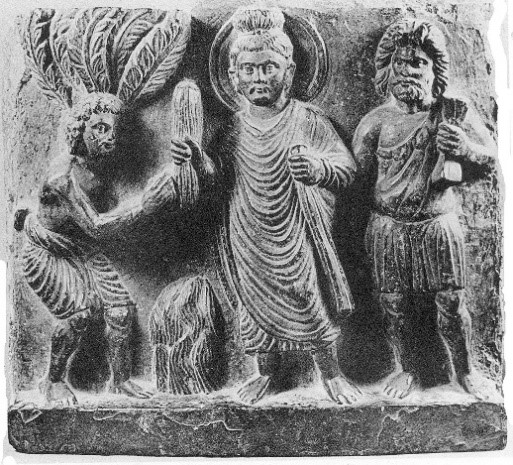 3.4 Haoma of Undying Spirit, Schist, H.39 cm, Gandhara, 2nd century CEPeshawar Museum, Pakistan
3.4 Haoma of Undying Spirit, Schist, H.39 cm, Gandhara, 2nd century CEPeshawar Museum, Pakistan
In âThe Lost Ring of Sankuntalaâ published in the Journal of Bihar and Orissa Research Society (Vol. VII, 1921), Surendra Nath Majumdar Shastri admits that poet Kalidasa borrowed the ring episode from a Greek source. The idea of Shakuntala dropping the keepsake ring into the water, which is swallowed by a fish caught by a fisherman pass into the hands of the palace guard has a charm that can be traced to Herodotus (484-431 BCE). According to the Greek historian[20] Polycrates (532 BCE), the king of Samos amplified his domain in the Aegean Sea. His friend Amasis, the king of Egypt advised him to neutralize his superpower by sacrificing something very precious. Accordingly, Polycrates took off his treasured gold emerald ring and threw it into the ocean. However, his irreplaceable loss caused great anguish when he returned with his fleet. Then a fisherman presented him a huge catch, and to everyoneâs astonishment, the kingâs signet ring was found in the belly of the fish, which Polycrates accepted as a good omen.5
The bilateral âShakuntalaâ terracotta medallion is a portable funerary votive The bilateral âShakuntalaâ terracotta medallion is a portable funerary votive related to the Greek oscillum marble discs. In Tillya Tepe burials the embossed gold plaques intended to be jewelry in some way were worn or suspended from clothing. The commemorative embossed plaques, coins, medals, and medallions are created by thesculptor-jeweler-engraver. First, he creates a large model of the coin in malleable clay or plaster and makes die-cast in a mold. The coin may be struck by dies, one for each side of the coin. Striking with hammers impress the image of the dies upon the blank metal disc or planchet. The countless Indo-Greek coins created for religious reasons are primarily devotional offerings derived from the Greek Hero cult. As commemoratives, the limited editions created for sale to honor particular individuals are medallic art in their own right. [..]
 Object Type: coin, Museum number: BNK,G.950[25]
Object Type: coin, Museum number: BNK,G.950[25]
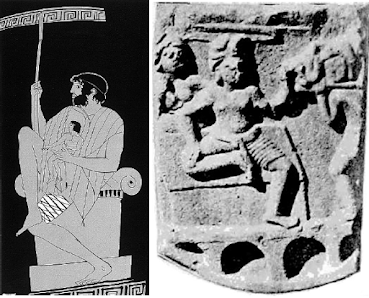 (a) Telephus with a bandaged thigh on an altar (Detail), Athenian red-figure pelike, c. 450 BCELondon: British Museum (E 382)(b) Telephus with bandaged thigh seated on Roman tomb, Sandstone, Bodh Gaya, 1st century CE Cue to Hercules and Buddha, in Magical Maha Maya
(a) Telephus with a bandaged thigh on an altar (Detail), Athenian red-figure pelike, c. 450 BCELondon: British Museum (E 382)(b) Telephus with bandaged thigh seated on Roman tomb, Sandstone, Bodh Gaya, 1st century CE Cue to Hercules and Buddha, in Magical Maha Maya
 Vetulonia, ÎμÏÏοÏθÏÏÏ
ÏοÏ: Male head wearing a Ketos headdress (sea monster skin)ÎÏιÏθÏÏÏ
ÏοÏ: Trident surrounded by two dolphinsΠαÏαÏομÏή, Historia Nummorum Italy 203[25]
Vetulonia, ÎμÏÏοÏθÏÏÏ
ÏοÏ: Male head wearing a Ketos headdress (sea monster skin)ÎÏιÏθÏÏÏ
ÏοÏ: Trident surrounded by two dolphinsΠαÏαÏομÏή, Historia Nummorum Italy 203[25]
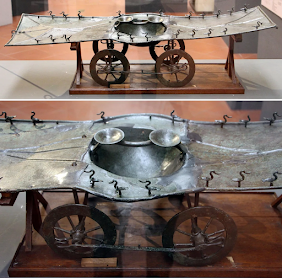 ΤελεÏοÏ
Ïγική άμαξα ÏοÏ
Vetulonia[30]
ΤελεÏοÏ
Ïγική άμαξα ÏοÏ
Vetulonia[30]
ΣÎÎÎÎΩΣÎÎΣ[1]. ÎÏιÏκÏÏηÏη AI: Î ÏÏάÏη "Perpetual Limbo" (ΠεÏÎ¯Î¿Î´Î¿Ï Î ÎÏαν ÏÎ¿Ï Î¤ÎµÏμαÏιÏμοÏ) ÏÏηÏιμοÏοιείÏαι για να ÏεÏιγÏάÏει μία καÏάÏÏαÏη ÏÏÎ¿Ï ÎºÎ¬ÏÎ¿Î¹Î¿Ï Î® κάÏι βÏίÏκεÏαι Ïε μια διαÏκή αναμονή, Ïε Îνα κενÏ, ÏÏÏÎ¯Ï ÎºÎ±Î¼Î¯Î± ÏÏ Î³ÎºÎµÎºÏιμÎνη εξÎλιξη. ÎÏοÏεί να αναÏÎÏεÏαι Ïε μια ÏολιÏική ÏÎ¿Ï ÎµÎ¼Ïοδίζει Ïην οικογενειακή ÎνÏÏη, ή Ïε μια καÏάÏÏαÏη ÏÏÎ¿Ï ÎºÎ¬ÏÎ¿Î¹Î¿Ï Î²ÏίÏκεÏαι Ïε μια καÏάÏÏαÏη αÏÏάθειαÏ, ÏÏÏÎ¯Ï Î½Î± μÏοÏεί να ÏÏοÏÏÏήÏει Ïε μια εÏÏμενη ÏάÏη ÏÎ·Ï Î¶ÏÎ®Ï ÏÎ¿Ï .[2]. ÎÏιÏκÏÏηÏη AI: A Purna-Kalash, also known as a Purna-Kumbha or Purna Ghata, is a sacred symbol in Hinduism, representing abundance, prosperity, and the source of life. It is a metal pot or vase, typically filled with water and adorned with auspicious elements like mango leaves and a coconut. The Purna-Kalash is revered in rituals and ceremonies, particularly weddings, births, and other auspicious occasions, symbolizing fertility, prosperity, and the presence of deities.[3]. ÎÏιÏκÏÏηÏη AI: ΣÏην ινδική θεαÏÏική ÏαÏάδοÏη, ο ÏÏÎ¿Ï Â«Sutradhar» (Î£Î¿Ï ÏÏάδαÏ) αναÏÎÏεÏαι ÏÏον ÏκηνοθÎÏη ή Ïον Ï ÏεÏÎ¸Ï Î½Î¿ για Ïην οÏγάνÏÏη ÏÎ·Ï ÏαÏάÏÏαÏηÏ. ΣÏην Îννοια ÏÎ·Ï Î»ÎξηÏ, ο Î£Î¿Ï ÏÏÎ¬Î´Î±Ï ÎµÎ¯Î½Î±Î¹ Î±Ï ÏÏÏ ÏÎ¿Ï ÎºÏαÏάει Ïη «ÏÏ ÏÏή» (Sutra) ή Ïο «νήμα» (Sutradhar) ÏÎ·Ï ÏαÏαÏÏάÏεÏÏ, δηλαδή Ïην ÎµÏ Î¸Ïνη για Ïην ÏοÏεία και Ïο αÏοÏÎλεÏμά ÏηÏ. ÎÏοÏεί εÏίÏÎ·Ï Î½Î± αναÏÎÏεÏαι Ïε μια κοινÏÏηÏα ανθÏÏÏÏν ÏÎ¿Ï Î±ÏÏολοÏνÏαι με Ïην καÏαÏÎºÎµÏ Î® ή Ïην εÏιÏÎºÎµÏ Î® ξÏλινÏν ανÏικειμÎνÏν. ÎÏιÏλÎον, ο ÏÏÎ¿Ï Â«Sutradhar» μÏοÏεί να ÏÏηÏιμοÏοιηθεί και Ïε μια μεÏαÏοÏική Îννοια, για να ÏεÏιγÏάÏει κάÏοιον ÏÎ¿Ï ÎµÎ¯Î½Î±Î¹ Ï ÏεÏÎ¸Ï Î½Î¿Ï Î³Î¹Î± Ïην οÏγάνÏÏη και Ïην εξÎλιξη Î¼Î¹Î±Ï Î´ÏαÏÏηÏιÏÏηÏÎ±Ï Î® Î¼Î¹Î±Ï ÎºÎ±ÏάÏÏαÏηÏ...[4]. ÎÏιÏκÏÏηÏη AI: In Latin, "oscillum" means a small face or mask, often hung up as an offering to deities. It's a diminutive of "os," meaning "face". The term also relates to the act of swinging, as the oscilla would be hung up and sway in the wind. This connection to swinging is reflected in the verb "oscillo" and the English word "oscillate".[5]. https://www.nps.gov/articles/secret-s.... https://en.wikipedia.org/wiki/FascesÎ...½ Vetulonia (Vatl), μία ÏÏν 12 ÏÏλεÏν ÏÎ·Ï ÎÏÏÎ¿Ï ÏÎºÎ¹ÎºÎ®Ï Î¿Î¼Î¿ÏÏονδίαÏ, ÎµÏ ÏÎθη η ÏαÏική ÏÏήλη ÏÎ¿Ï Auvele Feluske η οÏοία διαθÎÏει ÎνÏονα Ïα ίÏνη ÏÎ·Ï ÎÎ»Î»Î·Î½Î¹ÎºÎ®Ï ÎµÏιÏÏοήÏ: Το θÎμα ÏÎ¿Ï Î´Î¿ÏÏ ÏÏÏÎ¿Ï ÏολεμιÏÏÎ¿Ï ÏÎÏονÏα λάβÏÏ Î½ ÏÎ¿Ï Ï Î¹Î¿Î¸ÎµÏεί είναι ÏÏÎ½Î·Î¸ÎµÏ ÎºÎ±Î¹ διαδεδομÎνο ÏÏον ÎÎ¹Î³Î±Î¹Î±ÎºÏ ÏÏÏο, ÎµÎ½Ï Î¿ εικονιζÏÎ¼ÎµÎ½Î¿Ï ÎµÎ¯Î½Î±Î¹ εÏοδιαÏμÎÎ½Î¿Ï Î¼Îµ ÎοÏÎ¹Î½Î¸Î¹Î±ÎºÏ ÎºÏÎ¬Î½Î¿Ï (Bartolucci Chiara, und). Το Ïνομα Feluske ÏÎ·Ï ÏαÏÎ¹ÎºÎ®Ï ÎµÏιγÏαÏÎ®Ï ÎÏει ενδεÏομÎνÏÏ ÏÏ ÏÏεÏιÏθεί με Î±Ï ÏÏ ÏÎ¿Ï Î ÎµÏÏÎÏÏ (Bartolucci Chiara, und; ÎοÏÏÎ¸Î¿Ï 2021, Ïελ. 267). To fasces (ÏάκελοÏ) ÏÎ¿Ï ÎµÏ ÏÎθη ÏÏην Vetulonia θεÏÏείÏαι Ïο ÏÏÏÏÏÏÏ Ïο για Ïα αÏÏ ÏÎ¿Ï Ï Î¡ÏÎ¼Î±Î¯Î¿Ï Ï Ï Î¹Î¿Î¸ÎµÏηθÎν! (Lachlan MacKendrick 1960, p. 36/269). Τα γενικά ÏαÏακÏηÏιÏÏικά και η διάÏαξη ÏÎ¿Ï Ï ÏÏÎ³ÎµÎ¹Î¿Ï ÏάÏÎ¿Ï ÏÎ·Ï Vetulonia είναι ανάλογα με Îναν αÏÎ¹Î¸Î¼Ï Î¼Ï ÎºÎ·Î½Î±ÏκÏν ÏαÏικÏν μνημείÏν (Frothingham 1894).[9]. https://thejatakatales.com/katthahari.... A bundle of rods bound together around an ax with the blade projecting.ÎÏιÏκÏÏηÏη AI: The described image is called fasces, a bundle of rods bound together around an axe, with the axe blade projecting. It was a symbol of authority and power in ancient Rome, where lictors would carry it in front of magistrates. Here's a more detailed explanation:Fasces Definition:The term "fasces" comes from the Latin word "fascis," meaning "bundle". It refers to a bundle of rods bound together, typically with a projecting axe. Symbol of Authority: In ancient Rome, the fasces represented the power of the magistrate or leader. Lictors and Fasces: Lictors were attendants who carried the fasces, symbolizing the authority of the magistrate. Variations: The axe could be present or absent depending on the magistrate's position and whether they held the power of life and death.[12]. ÎÏιÏκÏÏηÏη AI: The Fasces: Ancient Rome's Most Dangerous Political Symbol ...The fasces, a symbol of rods bundled together and often including an axe, has a connection to ancient Greece, particularly through the double-headed axe known as the labrys. While the fasces is most famously associated with ancient Rome, its roots and symbolism are deeply intertwined with Greek culture, especially in areas like Crete. ÎλλÏÏÏε καÏά Ïο TLG είναι:TLGÏÎ¬ÎºÎµÎ»Î¿Ï [αÌ], á½, bundle, faggot, ÏÏÏ Î³Î¬Î½Ïν, ῥάβδÏν, Hdt.4.62,67; ξÏλÏν E.Cyc.242; δονάκÏν Opp.H.4.419 (ÏÏακÎÎ»Î¿Ï Ï codd.); á½Î»Î·Ï Th.2.77; οἱ Ï. Ïῶν ῥάβδÏν, = Lat. fasces, D.C.53.1; also written ÏÎ¬ÎºÎµÎ»Î»Î¿Ï Arist.Metaph.1016a1 (but ÏÎ¬ÎºÎµÎ»Î¿Ï codd. EJ and Alex.Aphr. and so all codd. in 1042b17), Aen.Tact.33.1, D.H.7.11, J.AJ5.7.4 (v.l. ÏακÎÎ»Î¿Ï Ï), Polyaen.7.6.9, but the form ÏÎ¬ÎºÎµÎ»Î¿Ï is corroborated by Phld.Rh.1.74 S., Edict.Diocl.32.26, and required by the metre in E. and Opp. ll.cc.; distd. from ÏÏÎ¬ÎºÎµÎ»Î¿Ï by Ptol.Asc.p.406 H.; cf. κομÏοÏακελοÏÏήμÏν.[15]. Offering of Kusa Grass by Sotthiya. Relief of votive stupa. Sikri, Pakistan. 2nd century CE. Central Archaeological Museum, Lahore, Pakistan Photo by John C. Huntington, Courtesy of the Huntington Photographic Archive of Buddhist and Asian Art <https://www.orientalistica.com/en/art... ÎÏιÏκÏÏηÏη AI: In his Histories, Book 3, chapters 41-42, Herodotus tells the story of Polycrates, the tyrant of Samos, and his famous ring. Polycrates, advised by Amasis, king of Egypt, to avoid misfortune by throwing away something valuable, throws a prized emerald ring into the sea. A fisherman, impressed by Polycrates' power, catches a large fish and presents it to him as a gift. When Polycrates' servants cut up the fish, they find the ring inside. The story highlights the gods' ability to reverse fortunes and illustrates Herodotus' interest in exploring themes of hubris and the ephemeral nature of success.[25]. https://www.britishmuseum.org/collect.... https://greekcoinage.org/iris/results....
ÎÏιÏκÏÏηÏη AIThe "Ritual Cart" from Vetulonia, a major Etruscan city, and its connection to Greek culture is a significant topic in ancient history. While the exact nature of the cart's purpose and the extent of Greek influence are debated, it's clear that it represents a complex interplay between Etruscan and Greek practices.What is the Ritual Cart?The "Ritual Cart" from Vetulonia refers to a terracotta artifact, specifically a model cart or chariot, found in an Etruscan tomb. This model depicts a vehicle, likely used in religious or funerary rituals, and is adorned with scenes of people, animals, and possibly gods.Greek Influence:Etruscan culture, while distinct, was deeply influenced by Greek culture, particularly in artistic, religious, and funerary practices. The Ritual Cart, with its depictions of Greek deities and scenes, is a testament to this influence. Deities:The figures depicted on the cart may represent Greek deities, indicating the adoption of Greek mythology within Etruscan religious beliefs.Funerary Rituals:The cart's placement in a tomb suggests its use in funerary rituals, which are also influenced by Greek practices. Processions, laments, and the laying out of the deceased (prothesis) were common features of both Etruscan and Greek burial rites.Artistic Style:The artistic style of the Ritual Cart, with its depictions of humans and animals, is also influenced by Greek art.Key Features and Interpretations:Function:The cart's purpose is debated, but it is generally believed to be related to religious or funerary rituals, possibly representing a procession or journey into the afterlife.Scenes Depicted:The scenes depicted on the cart may include mythological figures, sacrifices, or other religious events.Greek Influence:The presence of Greek deities and the overall artistic style suggest a strong Greek influence on Etruscan art and beliefs. In Conclusion:The Ritual Cart from Vetulonia is a fascinating artifact that sheds light on the complex relationship between Etruscan and Greek cultures. It demonstrates the adoption of Greek artistic styles, religious beliefs, and funerary practices by the Etruscans, highlighting the vibrant cultural exchange that occurred in ancient Italy.ÎÎÎÎÎÎÎΡÎΦÎÎ
https://www.academia.edu/45483233/Mag..., A. R. 2021. "Cue to Hercules and Buddha," in Magical Maha Maya - Epic Dimensions in Buddhist Art, Agam Kala Prakshan, New Delhi.
https://antigonejournal.com/2023/07/r.... Corey Brennan. 2023. "The Fasces: Ancient Romeâs Most Dangerous Political Symbol," in Antigone Journal, <https://antigonejournal.com/2023/07/r... (6 June 2025).
https://oxfordre.com/classics/display..., D. W. R. 2016. Oxford Classical Dictionary, s.v. Vetulonia
https://dokumen.pub/qdownload/the-mut... MacKendrick, P. 1960. The Mute Stones Speak: The Story of Archaeology in Italy, New York.
https://pergamos.lib.uoa.gr/uoa/dl/ob..., ÎÏ. 2021. "ÎοινÏνική μνήμη και ÏÎ±Ï ÏÏÏηÏα ÏÏην αÏÏαία Îλληνική ÏÏλη: Îι ÏεÏιÏÏÏÏÎµÎ¹Ï ÏηÏÎάÏÎ¿Ï , ÏÎ·Ï Î£Î±Î¼Î¿Î¸ÏÎ¬ÎºÎ·Ï ÎºÎ±Î¹ ÏÎ·Ï ÎÎ®Î¼Î½Î¿Ï Î±ÏÏ Ïην άÏιξη ÏÏν ÎλλήνÏν μÎÏÏι Ïην ÏÏÏεÏη αÏÏαιÏÏηÏα" (διδ. ÎÎÎ Î).
https://www.academia.edu/37143780/Ste... Chiara. (und). "Stele di Aule Feluske o stele del guerriero di Vetulonia," <https://www.academia.edu/37143780/Ste... (7 June 2025).
https://www.jstor.org/stable/496458A. L. Frothingham, Jr. 1894. "A Primitive Dome with Pendentives at Vetulonia," The American Journal of Archaeology and of the History of the Fine Arts 9 (2), pp. 213-216.

 Pluto abducting Proserpina (Persephone), Cinerary altar with a tabula without inscription, Marble, Bathsof Diocletian, Rome, 2nd century CE (Antonine Age 138-180 CE), National Roman Museum, Italy.Proserpina kidnapped Kircheriano Terme.jpg
Pluto abducting Proserpina (Persephone), Cinerary altar with a tabula without inscription, Marble, Bathsof Diocletian, Rome, 2nd century CE (Antonine Age 138-180 CE), National Roman Museum, Italy.Proserpina kidnapped Kircheriano Terme.jpg Ashram of sage Kanva depicted on terracotta plaque, 2nd century BCE3.1 Shakuntala medallion, Two-sided terracotta disc, Ã 7.7 cm, Bhita, India, 1st-2nd century CEKolkata: Indian Museum, Kolkata (N.S.2297)
Ashram of sage Kanva depicted on terracotta plaque, 2nd century BCE3.1 Shakuntala medallion, Two-sided terracotta disc, Ã 7.7 cm, Bhita, India, 1st-2nd century CEKolkata: Indian Museum, Kolkata (N.S.2297)
 3.2 Heavenly Arcadia stone-disc, Gandhara, Lahore, Private collection, 2nd century CE(After Bopearachchi)
3.2 Heavenly Arcadia stone-disc, Gandhara, Lahore, Private collection, 2nd century CE(After Bopearachchi)To begin with, a terracotta pendant from Bhita near Allahabad depicts a sylvan glade in which the relentless Hades forcibly carries off Persephone in a four-horse chariot. The tiny detail correlates with Plutoâs abduction carved on a 2nd-century Roman cinerary altar.1 At the doorway to the Chaitya-Griha next to a bouquet of six flowers with six-petals earth-mother goddess dashes after the chariot. The peacock and deer close to a lotus pond laud the sacred abode of Maha Vihara Maya Devi worshiped as Lakshmi. At the distant horizon a couple appears behind the fenced-in sanctuary conceived as the home of the blessed after death (3.1). A corresponding stone-disc with miraculous trees encircled by meandering lotus pool is where the souls find a final resting place. In the lower right of the fragment from Gandhara is the couple in a horse-drawn chariot. In the transient art of Perpetual Limbo the heroic and the untainted float in the clouds, and where the cloud ends the divine couple converse by the fenced-in wagon-vaulted Chaitya-Vihara.2 The crowning touch to the barrel roof is a row of Purna-Kalash finials denoting the abode of gods and goddesses (3.2). The dream vision of a Pure Land Elysium carved on the stonedisc from Gandhara is similar to the pictorial relief of Arcadia stamped on both sides of the Bhita terracotta disc just 7.7 cm in diameter. The small stone-disc and the mold for the superfine Bhita medallion were doubtlessly made by an ivory carver or gem engraver.The repetition of everlasting Pure Land indicates that the sculptors had access to pattern books managed by a Sutradhar. The unique Greco-Buddhist ex-votos are strikingly similar to the much larger Greek marble oscillum discs typically suspended in a temple colonnade or from a tree.
ÎÏ Î±ÏÏίÏÎ¿Ï Î¼Îµ με Îνα Ïήλινο κÏεμαÏÏÏ ÎºÏÏμημα αÏÏ Ïην Bhita ÏληÏίον ÏÎ¿Ï Allahabad Ïο οÏοίο αÏεικονίζει Îνα δαÏÎ¹ÎºÏ Î¾ÎÏÏÏο ÏÏÎ¿Ï Î¿ Î±Î´Ï ÏÏÏηÏÎ¿Ï ÎÎ´Î·Ï Î±ÏÏάζει βίαια Ïην ΠεÏÏεÏÏνη με Îνα άÏμα ÏεÏÏάÏÏν αλÏγÏν. ΠμικÏοÏκοÏική λεÏÏομÎÏεια ÏÏ ÏÏεÏίζεÏαι με Ïην αÏαγÏγή ÏÎ¿Ï Î Î»Î¿ÏÏÏνα, ÏκαλιÏμÎνη Ïε Îνα ÏÏμαÏÎºÏ ÏεÏÏοδÏÏο βÏÎ¼Ï ÏÎ¿Ï 2Î¿Ï Î±Î¹Ïνα.1 ΣÏην ÏÏÏÏα ÏÎ¿Ï Chaitya-Griha, δίÏλα Ïε Îνα μÏÎ¿Ï ÎºÎÏο αÏÏ Îξι Î»Î¿Ï Î»Î¿Ïδια με Îξι ÏÎÏαλα, η θεά ÏÎ·Ï Î³Î·Ï-μηÏÎÏÎ±Ï ÏÏÎÏει ÏίÏÏ Î±ÏÏ Ïο άÏμα. Το ÏαγÏνι και Ïο ελάÏι κονÏά Ïε μια λίμνη με λÏÏÏ Î´Î¿Î¾Î¬Î¶Î¿Ï Î½ Ïην ιεÏή καÏοικία ÏÎ·Ï Maha Vihara Maya Devi, ÏÎ¿Ï Î»Î±ÏÏÎµÏ ÏÏαν ÏÏ Lakshmi. ΣÏον μακÏÎ¹Î½Ï Î¿ÏίζονÏα, Îνα Î¶ÎµÏ Î³Î¬Ïι εμÏανίζεÏαι ÏίÏÏ Î±ÏÏ Ïο ÏεÏιÏÏαγμÎνο ιεÏÏ, ÏÎ¿Ï Î¸ÎµÏÏείÏαι ÏÏ Ïο ÏÏίÏι ÏÏν ÎµÏ Î»Î¿Î³Î·Î¼ÎνÏν μεÏά θάναÏον (3.1). ÎÎ½Î±Ï Î±Î½ÏίÏÏοιÏÎ¿Ï Î»Î¯Î¸Î¹Î½Î¿Ï Î´Î¯ÏÎºÎ¿Ï Î¼Îµ Î¸Î±Ï Î¼Î±ÏÎ¿Ï Ïγά δÎνÏÏα, ÏεÏιÏÏÎ¹Î³Ï ÏιÏμÎÎ½Î¿Ï Î±ÏÏ ÎµÎ»Î¹ÎºÎ¿ÎµÎ¹Î´Î® λίμνη με λÏÏÏ, είναι Ïο Ïημείο ÏÏÎ¿Ï Î¿Î¹ ÏÏ ÏÎÏ Î²ÏίÏÎºÎ¿Ï Î½ Ïην Ïελική καÏοικία. ÎάÏÏ Î´ÎµÎ¾Î¹Î¬ ÏÏο θÏαÏÏμα αÏÏ Ïην Gandhara ÏαÏÎ¿Ï ÏιάζεÏαι Ïο Î¶ÎµÏ Î³Î¬Ïι Ïε Îνα ιÏÏήλαÏο άÏμα. ΣÏην μεÏαβαÏική ÏÎÏνη ÏÎ¿Ï Perpetual Limbo[1], Ïο ηÏÏÎ¹ÎºÏ ÎºÎ±Î¹ Ïο αμÏÎ»Ï Î½Ïο εÏιÏλÎÎ¿Ï Î½ ÏÏα ÏÏννεÏα, και εκεί ÏÎ¿Ï ÏελειÏνει Ïο ÏÏννεÏο, Ïο θεÏÎºÏ Î¶ÎµÏ Î³Î¬Ïι ÏÏ Î½Î¿Î¼Î¹Î»ÎµÎ¯ δίÏλα ÏÏην ÏεÏιÏÏαγμÎνη, θολÏÏή Chaitya-Vihara.2 ΠκοÏÏ Ïαία Ïινελιά ÏÏην οÏοÏή Ïε ÏÏήμα βαÏÎµÎ»Î¹Î¿Ï ÎµÎ¯Î½Î±Î¹ μια ÏειÏά αÏÏ Î±ÏÎ¿Î»Î®Î¾ÎµÎ¹Ï Purna-Kalash[2] ÏÎ¿Ï Ï ÏοδηλÏÎ½Î¿Ï Î½ Ïην καÏοικία θεÏν και θεαινÏν (3.2). Το ονειÏÎ¹ÎºÏ ÏÏαμα ενÏÏ ÎÎ»Ï ÏÎ¯Î¿Ï ÏÎ·Ï ÎÎ³Î½Î®Ï ÎηÏ, ÏκαλιÏμÎνο ÏÏον λίθινο δίÏκο αÏÏ Ïην Gandhara, είναι ÏαÏÏμοιο με Ïο εικονογÏαÏÎ¹ÎºÏ Î±Î½Î¬Î³Î»Ï Ïο ÏÎ·Ï Arcadia, ÏÎ¿Ï ÎµÎ¯Î½Î±Î¹ ÏÏÏαγιÏμÎνο και ÏÏÎ¹Ï Î´Ïο ÏÎ»ÎµÏ ÏÎÏ ÏÎ¿Ï Î´Î¯ÏÎºÎ¿Ï Î±ÏÏ ÏεÏακÏÏα ÏÎ·Ï Bhita, διαμÎÏÏÎ¿Ï Î¼ÏÎ»Î¹Ï 7,7 εκαÏοÏÏÏν. ΠμικÏÏÏ ÏÎÏÏÎ¹Î½Î¿Ï Î´Î¯ÏÎºÎ¿Ï ÎºÎ±Î¹ Ïο καλοÏÏι για Ïο εξαιÏεÏικά λεÏÏÏ Î¼ÎµÏάλλιο ÏÎ·Ï Bhita αναμÏίβολα καÏαÏÎºÎµÏ Î¬ÏÏηκαν αÏÏ Îναν γλÏÏÏη ελεÏανÏÏδονÏÎ¿Ï Î® ÏαÏάκÏη ÏολÏÏιμÏν λίθÏν.
ΠεÏανάληÏη ÏÎ·Ï Î±Î¹ÏÎ½Î¹Î±Ï ÎÎ³Î½Î®Ï ÎÎ·Ï Ï ÏοδηλÏνει ÏÏι οι γλÏÏÏÎµÏ ÎµÎ¯Ïαν ÏÏÏÏβαÏη Ïε βιβλία μοÏίβÏν ÏÎ¿Ï Î´Î¹Î±ÏειÏιζÏÏαν ÎÎ½Î±Ï Sutradhar[3]. Τα μοναδικά ÎµÎ»Î»Î·Î½Î¿Î²Î¿Ï Î´Î¹ÏÏικά αναθήμαÏα είναι ενÏÏ ÏÏÏιακά ÏαÏÏμοια με ÏÎ¿Ï Ï ÏÎ¿Î»Ï Î¼ÎµÎ³Î±Î»ÏÏεÏÎ¿Ï Ï ÎµÎ»Î»Î·Î½Î¹ÎºÎ¿ÏÏ Î¼Î±ÏμάÏÎ¹Î½Î¿Ï Ï Î´Î¯ÏÎºÎ¿Ï Ï ÏαλανÏÏÏεÏν[4] ÏÎ¿Ï ÏÏ Î½Î®Î¸ÏÏ Î±Î¹ÏÏοÏνÏαι ανηÏÏημÎνοι Ïε μια κιονοÏÏοιÏία Î½Î±Î¿Ï Î® αÏÏ Îνα δÎνÏÏο.
The Kattahari JatakamIn patriotic archaeology, the superb vision of Arcadia captured in the votive discs is eagerly taken up as the âSign of Shakuntalaâ from Kalidasaâs Abhijnana-Sakuntala, a Sanskrit classic play of the early Gupta period. The signet ring as a âSign of Acknowledgmentâ is critical to the love story of Shakuntala brought up in a secluded hermitage.3 Brahmadatta the King of Banaras rode into the woodlands on his chariot and came upon Shakuntala. A dream conception came about in their brief embrace.Brahmadatta departed saying, âIf it is a girl let my signet ring nurture the child, if not bring the boy and the ring back to me.â Shakuntala took the boy to meet his father but on the way, the ring slid into a river and the king could not recognize Shakuntala without the ring. The same story in the Buddhist Kattahari Jatakam translated by E. B. Cowell tells that when the King of Banaras embraced the damsel the Bodhisattva entered her womb like the bolts of Indra. But without the keepsake signet ring, the King of Banaras would not acknowledge his son. To establish her sonâs birthright, the mother swung the child and chucked him up into the air declaring that he would fall and die if he is not the kingâs [...] son. The toddler sat cross-legged in space, then descended to sit on the lap of his father the king. Later, the Bodhisattva ruled Banaras as the renowned Katthawahna bearer.
 Daniel Chester French's "Abraham Lincoln" prominently depicts fasces on the ends of the armrests. (NPS)[5]
Daniel Chester French's "Abraham Lincoln" prominently depicts fasces on the ends of the armrests. (NPS)[5] Earliest depiction of a fasces, c. 610 BC, discovered as a grave good in Vetulonia in 1897[7]
Earliest depiction of a fasces, c. 610 BC, discovered as a grave good in Vetulonia in 1897[7]Kattha means a bundle of sticks or rods in Sanskrit. A bundle of rods bound together around an ax with the blade projecting called fasces heralded magistral power in ancient Rome. The emblem of authority might also indicate the Avestan barez, the baresman bundle linked to Haoma performed for strength, good health, and undying spirit. Zoroastrian baresman bundle carried by Persian Magi is attested by Strabo and Buddhist artworks. Parthia was then allied to Kushan South Asia known as the Yavana Greek Kingdom. It is said that the Satrap of Barygaza, modern Bharuch formerly known as Broach, augmented wealth by importing Yavana dancing girls and singing boys, now colloquially Bacha bazi and Bacha posh in Afghanistan. A couple of reliefs from Gandhara depict a bundle of sticks or more likely sanctified Kusha grass known as Darbha (Desmotachya bipinnata) said to purify ritual offerings (3.3). The halo splits the terrestrials from the celestial Buddhas in a shallow aedicule framed by attachedCorinthian pillars, which as an architectural monument marks the funerary altar of a mausoleum. At right, the acolyte holding Vajra in hand is Vajrapani unfailingly called Hercules, the protector and the psychopomp guiding newly deceased souls from Earth to the afterlife. The sculptured sanctuary of The Undying Spirit is similar to the mythological subjects carved on contemporary Asiatic Roman sarcophagi that outfitted burials when Christian faith in bodily resurrection spread. The attached columns framing the frieze is derived from the Romans. Four similar engaged fluted Corinthian columns frame the façade of Triumphal Arch of Septimius Severus (145-211 CE) in Roman Forum dedicated in 203 to commemorate the Parthian victories in 195-196.
Το Kattahari Jatakam[9]ΣÏην ÏαÏÏιÏÏική αÏÏαιολογία, Ïο Ï ÏÎÏοÏο ÏÏαμα ÏÎ·Ï ÎÏÎºÎ±Î´Î¯Î±Ï ÏÎ¿Ï Î±ÏοÏÏ ÏÏνεÏαι ÏÏÎ¿Ï Ï Î±Î½Î±Î¸Î·Î¼Î±ÏικοÏÏ Î´Î¯ÏÎºÎ¿Ï Ï Î³Î¯Î½ÎµÏαι δεκÏÏ Î¼Îµ ÎµÎ½Î¸Î¿Ï ÏιαÏÎ¼Ï ÏÏ Ïο "Sign of Shakuntala" αÏÏ Ïο Abhijnana-Sakuntala ÏÎ¿Ï Kalidasa, Îνα κλαÏÎ¹ÎºÏ ÏανÏκÏιÏÎ¹ÎºÏ ÎÏγο ÏÎ·Ï ÏÏÏÎ¹Î¼Î·Ï ÏεÏιÏÎ´Î¿Ï Gupta. Το ÏÏÏαγιÏÏÎ¹ÎºÏ Î´Î±ÎºÏÏ Î»Î¯Î´Î¹ ÏÏ "Σημείο ÎναγνÏÏίÏεÏÏ" είναι κÏίÏιμο για Ïην ιÏÏοÏία αγάÏÎ·Ï ÏÎ·Ï Shakuntala ÏÎ¿Ï Î¼ÎµÎ³Î¬Î»ÏÏε Ïε Îνα αÏομονÏμÎνο εÏημηÏήÏιο.3 Î Brahmadatta, βαÏÎ¹Î»Î¹Î¬Ï ÏÎ¿Ï Banaras, μÏήκε ÏÏα δάÏη με Ïο άÏμα ÏÎ¿Ï ÎºÎ±Î¹ ÏÏ Î½Î¬Î½ÏηÏε Ïη Shakuntala. Îια ονειÏική ÏÏλληÏη ÏÏαγμαÏοÏοιήθηκε καÏά Ïην ÏÏνÏομη ÏεÏίÏÏÏ Î¾Î® ÏÎ¿Ï Ï.
Î Brahmadatta ÎÏÏ Î³Îµ λÎγονÏαÏ: «Îν είναι κοÏίÏÏι, Î±Ï Î±Î½Î±Î¸ÏÎÏει Ïο Ïαιδί Ïο ÏÏÏαγιÏÏÎ¹ÎºÏ Î´Î±ÎºÏÏ Î»Î¯Î´Î¹ Î¼Î¿Ï , αν ÏÏι, ÏÎÏÏε Î¼Î¿Ï ÏίÏÏ Ïο αγÏÏι Î¼Î±Î¶Ï ÎºÎ±Î¹ Ïο δαÏÏÏ Î»Î¯Î´Î¹Â». Î Shakuntala ÏήÏε Ïο αγÏÏι για να ÏÏ Î½Î±Î½ÏήÏει Ïον ÏαÏÎÏα ÏÎ¿Ï , αλλά ÏÏο δÏÏμο, Ïο δαÏÏÏ Î»Î¯Î´Î¹ γλίÏÏÏηÏε Ïε Îνα ÏοÏάμι και ο βαÏÎ¹Î»Î¹Î¬Ï Î´ÎµÎ½ μÏοÏοÏÏε να αναγνÏÏίÏει Ïη Shakuntala ÏÏÏÎ¯Ï Ïο δαÏÏÏ Î»Î¯Î´Î¹. Πίδια ιÏÏοÏία ÏÏο Î²Î¿Ï Î´Î¹ÏÏÎ¹ÎºÏ Kattahari Jatakam, μεÏαÏÏαÏμÎνο αÏÏ Ïον E. B. Cowell, αναÏÎÏει ÏÏι ÏÏαν ο ÎαÏÎ¹Î»Î¹Î¬Ï ÏÎ¿Ï Banaras αγκάλιαÏε Ïην κοÏÎλα, ο Bodhisattva μÏήκε ÏÏη μήÏÏα ÏÎ·Ï Ïαν Ïον ÏÏÏÏη (ή μάνδαλο) ÏÎ¿Ï Indra. Îλλά ÏÏÏÎ¯Ï Ïο αναμνηÏÏÎ¹ÎºÏ Î´Î±ÏÏÏ Î»Î¯Î´Î¹-ÏÏÏαγίδα, ο ÎαÏÎ¹Î»Î¹Î¬Ï ÏÎ¿Ï Banaras δεν αναγνÏÏιζε Ïον γιο ÏÎ¿Ï . Îια να εδÏαιÏÏει Ïο δικαίÏμα ÏÏÏÏοÏÎ¿ÎºÎ¯Î±Ï ÏÎ¿Ï Î³Î¹Î¿Ï ÏηÏ, η μηÏÎÏα κοÏνηÏε Ïο Ïαιδί και Ïο ÏÎÏαξε ÏÏον αÎÏα, δηλÏνονÏÎ±Ï ÏÏι θα ÎÏεÏÏε και θα ÏÎθαινε αν δεν ήÏαν ο Î³Î¹Î¿Ï ÏÎ¿Ï Î²Î±Ïιλιά [...]. Το νήÏιο καθÏÏαν ÏÏÎ±Ï ÏοÏÏδι ÏÏο ÎºÎµÎ½Ï ÎºÎ±Î¹ ÏÏη ÏÏ Î½ÎÏεια καÏÎβαινε για να καθίÏει ÏÏην αγκαλιά ÏÎ¿Ï ÏαÏÎÏα ÏÎ¿Ï , ÏÎ¿Ï Î²Î±Ïιλιά. ÎÏγÏÏεÏα, ο Bodhisattva ÎºÏ Î²ÎÏνηÏε Ïον Banaras ÏÏ Î¿ διάÏÎ·Î¼Î¿Ï ÏοÏÎÎ±Ï ÏÎ·Ï Katthawahna.
Kattha[10] Ïημαίνει μια δÎÏμη αÏÏ Ïαβδιά ή ÏÎ¬Î²Î´Î¿Ï Ï ÏÏα ÏανÏκÏιÏικά. Îια δÎÏμη αÏÏ ÏÎ¬Î²Î´Î¿Ï Ï Î´ÎµÎ¼ÎÎ½ÎµÏ Î¼ÎµÏÎ±Î¾Ï ÏÎ¿Ï Ï Î³ÏÏÏ Î±ÏÏ Îνα ÏÏεκοÏÏι με Ïη λεÏίδα να ÏÏοεξÎÏει, ÏÎ¿Ï Î¿Î½Î¿Î¼Î¬Î¶ÎµÏαι fasces, ÏÏÎ¿Î¼Î®Î½Ï Îµ Ïην ÎºÏ ÏιαÏÏική δÏναμη ÏÏην αÏÏαία ΡÏμη.[12] Το Îμβλημα ÏÎ·Ï ÎµÎ¾Î¿Ï ÏÎ¯Î±Ï Î¼ÏοÏεί εÏίÏÎ·Ï Î½Î± Ï ÏοδηλÏνει Ïο Avestan barez, Ïη δÎÏμη ÏÎ¿Ï baresman ÏÎ¿Ï ÏÏ Î½Î´ÎεÏαι με Ïο Haoma ÏÎ¿Ï ÎµÎºÏελείÏαι για δÏναμη, καλή Ï Î³ÎµÎ¯Î± και αθάναÏο ÏνεÏμα. ΠδÎÏμη ÏÏν ÎÏÏοαÏÏÏÏν ÏÎ¿Ï ÎºÎ¿Ï Î²Î±Î»Î¿ÏÏαν Î ÎÏÏÎµÏ Îάγοι μαÏÏÏ ÏείÏαι αÏÏ Ïον ΣÏÏάβÏνα και Î²Î¿Ï Î´Î¹ÏÏικά ÎÏγα ÏÎÏνηÏ. ΠΠαÏθία ÏÏÏε ÏÏ Î¼Î¼Î¬ÏηÏε με Ïο Kushan ÏÎ·Ï ÎÏÏÎ¹Î±Ï ÎÏίαÏ, γνÏÏÏÏ ÏÏ Ïο ÎÎ»Î»Î·Î½Î¹ÎºÏ ÎαÏίλειο ÏÏν Yavana. ÎÎγεÏαι ÏÏι ο ΣαÏÏάÏÎ·Ï ÏÎ·Ï Barygaza, ÏÎ¿Ï ÏÏγÏÏÎ¿Î½Î¿Ï Bharuch, ÏαλαιÏÏεÏα γνÏÏÏÎ¿Ï ÏÏ Broach, αÏξηÏε Ïον ÏλοÏÏο ειÏάγονÏÎ±Ï ÎºÎ¿ÏίÏÏια ÏÎ¿Ï ÏÏÏÎµÏ Î±Î½ και αγÏÏια ÏÎ¿Ï ÏÏÎ±Î³Î¿Ï Î´Î¿ÏÏαν αÏÏ Ïα Yavana, ÏÏÏα γνÏÏÏά ÏÏ Bacha bazi και Bacha posh ÏÏο ÎÏγανιÏÏάν. ÎεÏικά Î±Î½Î¬Î³Î»Ï Ïα αÏÏ Ïη Gandhara αÏÎµÎ¹ÎºÎ¿Î½Î¯Î¶Î¿Ï Î½ μια δÎÏμη αÏÏ Ïαβδιά ή, Ïιο ÏιθανÏ, αγιαÏμÎνο γÏαÏίδι Kusha, γνÏÏÏÏ ÏÏ Darbha (Desmotachya bipinnata), ÏÎ¿Ï Î»ÎγεÏαι ÏÏι καθαÏίζει ÏÎ¹Ï ÏελεÏÎ¿Ï ÏγικÎÏ ÏÏοÏÏοÏÎÏ (3.3). Το ÏÏÏοÏÏÎÏανο ÏÏÏίζει ÏÎ¿Ï Ï Î³Î®Î¹Î½Î¿Ï Ï Î±ÏÏ ÏÎ¿Ï Ï Î¿Ï ÏÎ¬Î½Î¹Î¿Ï Ï ÎοÏÎ´ÎµÏ Ïε Îνα ÏηÏÏ ÎºÎ¹Î¿Î½ÏκÏανο ÏλαιÏιÏμÎνο αÏÏ ÏÏοÏαÏÏημÎÎ½Î¿Ï Ï ÎºÎ¿ÏινθιακοÏÏ ÎºÎ¯Î¿Î½ÎµÏ, Ïο οÏοίο ÏÏ Î±ÏÏιÏεκÏÎ¿Î½Î¹ÎºÏ Î¼Î½Î·Î¼ÎµÎ¯Î¿ ÏημαÏοδοÏεί Ïον ÏαÏÎ¹ÎºÏ Î²ÏÎ¼Ï ÎµÎ½ÏÏ Î¼Î±Ï ÏÏÎ»ÎµÎ¯Î¿Ï . ΣÏα δεξιά, ο ακÏÎ»Î¿Ï Î¸Î¿Ï ÏÎ¿Ï ÎºÏαÏάει Ïη Vajra ÏÏο ÏÎÏι είναι ο Vajrapani, ÏÎ¿Ï Î¿Î½Î¿Î¼Î¬Î¶ÎµÏαι αναμÏιÏβήÏηÏα ÎÏακλήÏ, ο ÏÏοÏÏάÏÎ·Ï ÎºÎ±Î¹ ο ÏÏ ÏοÏομÏÏÏ ÏÎ¿Ï ÎºÎ±Î¸Î¿Î´Î·Î³ÎµÎ¯ ÏÎ¹Ï ÏÏÏÏÏαÏα νεκÏÎÏ ÏÏ ÏÎÏ Î±ÏÏ Ïη Îη ÏÏη μεÏά θάναÏον ζÏή. Το Î³Î»Ï ÏÏÏ Î¹ÎµÏÏ ÏÎ¿Ï ÎθάναÏÎ¿Ï Î Î½ÎµÏμαÏÎ¿Ï ÎµÎ¯Î½Î±Î¹ ÏαÏÏμοιο με Ïα Î¼Ï Î¸Î¿Î»Î¿Î³Î¹ÎºÎ¬ θÎμαÏα ÏÎ¿Ï ÎµÎ¯Î½Î±Î¹ ÏκαλιÏμÎνα Ïε ÏÏγÏÏÎ¿Î½ÎµÏ Î±ÏιαÏικÎÏ ÏÏμαÏκÎÏ ÏαÏκοÏÎ¬Î³Î¿Ï Ï ÏÎ¿Ï ÏÏÏλιζαν ÏÎ¹Ï ÏαÏÎÏ ÏÏαν εξαÏλÏθηκε η ÏÏιÏÏιανική ÏίÏÏη ÏÏη ÏÏμαÏική ανάÏÏαÏη. Îι ÏÏοÏαÏÏημÎνοι ÎºÎ¯Î¿Î½ÎµÏ ÏÎ¿Ï ÏλαιÏιÏÎ½Î¿Ï Î½ Ïη ζÏÏÏÏο ÏÏοÎÏÏονÏαι αÏÏ ÏÎ¿Ï Ï Î¡ÏÎ¼Î±Î¯Î¿Ï Ï. ΤÎÏÏεÏÎ¹Ï ÏαÏÏμοιοι εμÏλεκÏμενοι ÏαβδÏÏοί κοÏινθιακοί ÎºÎ¯Î¿Î½ÎµÏ ÏλαιÏιÏÎ½Î¿Ï Î½ Ïην ÏÏÏÏοÏη ÏÎ·Ï ÎÏÎ¹Î±Î¼Î²Î¹ÎºÎ®Ï ÎÏÎ¯Î´Î±Ï ÏÎ¿Ï Î£ÎµÏÏÎ¯Î¼Î¹Î¿Ï Î£ÎµÎ²Î®ÏÎ¿Ï (145-211 μ.Χ.) ÏÏη ΡÏμαÏκή ÎγοÏά, η οÏοία αÏιεÏÏθηκε Ïο 203 για να ÏιμήÏει ÏÎ¹Ï Î½Î¯ÎºÎµÏ ÏÏν ΠάÏθÏν Ïο 195-196.
 3.3 Sanctuary of Undying Spirit, Schist, H.38 cm, Gandhara, 2nd century CELahore Museum, Pakistan[15]
3.3 Sanctuary of Undying Spirit, Schist, H.38 cm, Gandhara, 2nd century CELahore Museum, Pakistan[15]The baresman symbol of the Magi and the Zoroastrian faith spread from Central Asia to the Pamirs and Gandhara where the Buddha holding a baresman bundle [..] sanctifies.4 Hercules crops up wherever the Buddha goes, which is also Greco-Roman heroic homoeroticism. Three men of different social strata come together in the Peshawar frieze and Hercules standing close to Buddha is true to form (3.4). The tableau unfolds as if on a stage; bearded Hercules with a shock of hair resembles Taranis the Celtic thunder god with the wheel mentioned by the Roman poet Lucan (39-65 CE) in his epic poem Pharsalia. Barefoot Hercules wearing the short, off-shoulder rough garment might as well be a freed Celtic slave. But his bulging waist is a furtive comment on his prosperous pouch and propitious nature. The thunderbolt in his hand appears like a bundle of manuscript and he holds a flywhisk to signify the regality of the Buddha distinguished by halo (3.5). The beardless but mustached Buddha with top knot wears a tunic and a palla draped over both his shoulders. The barefoot men striding forward realistically is certainly an offshoot of Greco-Roman theater. Stylistically the Berlin relief is similar to the Peshawar frieze suggesting the hand of the same sculptor. He seems to confirm that the frieze is an eyewitness account of the Mystery plays.
 3.4 Haoma of Undying Spirit, Schist, H.39 cm, Gandhara, 2nd century CEPeshawar Museum, Pakistan
3.4 Haoma of Undying Spirit, Schist, H.39 cm, Gandhara, 2nd century CEPeshawar Museum, PakistanIn âThe Lost Ring of Sankuntalaâ published in the Journal of Bihar and Orissa Research Society (Vol. VII, 1921), Surendra Nath Majumdar Shastri admits that poet Kalidasa borrowed the ring episode from a Greek source. The idea of Shakuntala dropping the keepsake ring into the water, which is swallowed by a fish caught by a fisherman pass into the hands of the palace guard has a charm that can be traced to Herodotus (484-431 BCE). According to the Greek historian[20] Polycrates (532 BCE), the king of Samos amplified his domain in the Aegean Sea. His friend Amasis, the king of Egypt advised him to neutralize his superpower by sacrificing something very precious. Accordingly, Polycrates took off his treasured gold emerald ring and threw it into the ocean. However, his irreplaceable loss caused great anguish when he returned with his fleet. Then a fisherman presented him a huge catch, and to everyoneâs astonishment, the kingâs signet ring was found in the belly of the fish, which Polycrates accepted as a good omen.5
The bilateral âShakuntalaâ terracotta medallion is a portable funerary votive The bilateral âShakuntalaâ terracotta medallion is a portable funerary votive related to the Greek oscillum marble discs. In Tillya Tepe burials the embossed gold plaques intended to be jewelry in some way were worn or suspended from clothing. The commemorative embossed plaques, coins, medals, and medallions are created by thesculptor-jeweler-engraver. First, he creates a large model of the coin in malleable clay or plaster and makes die-cast in a mold. The coin may be struck by dies, one for each side of the coin. Striking with hammers impress the image of the dies upon the blank metal disc or planchet. The countless Indo-Greek coins created for religious reasons are primarily devotional offerings derived from the Greek Hero cult. As commemoratives, the limited editions created for sale to honor particular individuals are medallic art in their own right. [..]
 Object Type: coin, Museum number: BNK,G.950[25]
Object Type: coin, Museum number: BNK,G.950[25] (a) Telephus with a bandaged thigh on an altar (Detail), Athenian red-figure pelike, c. 450 BCELondon: British Museum (E 382)(b) Telephus with bandaged thigh seated on Roman tomb, Sandstone, Bodh Gaya, 1st century CE Cue to Hercules and Buddha, in Magical Maha Maya
(a) Telephus with a bandaged thigh on an altar (Detail), Athenian red-figure pelike, c. 450 BCELondon: British Museum (E 382)(b) Telephus with bandaged thigh seated on Roman tomb, Sandstone, Bodh Gaya, 1st century CE Cue to Hercules and Buddha, in Magical Maha Maya Vetulonia, ÎμÏÏοÏθÏÏÏ
ÏοÏ: Male head wearing a Ketos headdress (sea monster skin)ÎÏιÏθÏÏÏ
ÏοÏ: Trident surrounded by two dolphinsΠαÏαÏομÏή, Historia Nummorum Italy 203[25]
Vetulonia, ÎμÏÏοÏθÏÏÏ
ÏοÏ: Male head wearing a Ketos headdress (sea monster skin)ÎÏιÏθÏÏÏ
ÏοÏ: Trident surrounded by two dolphinsΠαÏαÏομÏή, Historia Nummorum Italy 203[25] ΤελεÏοÏ
Ïγική άμαξα ÏοÏ
Vetulonia[30]
ΤελεÏοÏ
Ïγική άμαξα ÏοÏ
Vetulonia[30]ΣÎÎÎÎΩΣÎÎΣ[1]. ÎÏιÏκÏÏηÏη AI: Î ÏÏάÏη "Perpetual Limbo" (ΠεÏÎ¯Î¿Î´Î¿Ï Î ÎÏαν ÏÎ¿Ï Î¤ÎµÏμαÏιÏμοÏ) ÏÏηÏιμοÏοιείÏαι για να ÏεÏιγÏάÏει μία καÏάÏÏαÏη ÏÏÎ¿Ï ÎºÎ¬ÏÎ¿Î¹Î¿Ï Î® κάÏι βÏίÏκεÏαι Ïε μια διαÏκή αναμονή, Ïε Îνα κενÏ, ÏÏÏÎ¯Ï ÎºÎ±Î¼Î¯Î± ÏÏ Î³ÎºÎµÎºÏιμÎνη εξÎλιξη. ÎÏοÏεί να αναÏÎÏεÏαι Ïε μια ÏολιÏική ÏÎ¿Ï ÎµÎ¼Ïοδίζει Ïην οικογενειακή ÎνÏÏη, ή Ïε μια καÏάÏÏαÏη ÏÏÎ¿Ï ÎºÎ¬ÏÎ¿Î¹Î¿Ï Î²ÏίÏκεÏαι Ïε μια καÏάÏÏαÏη αÏÏάθειαÏ, ÏÏÏÎ¯Ï Î½Î± μÏοÏεί να ÏÏοÏÏÏήÏει Ïε μια εÏÏμενη ÏάÏη ÏÎ·Ï Î¶ÏÎ®Ï ÏÎ¿Ï .[2]. ÎÏιÏκÏÏηÏη AI: A Purna-Kalash, also known as a Purna-Kumbha or Purna Ghata, is a sacred symbol in Hinduism, representing abundance, prosperity, and the source of life. It is a metal pot or vase, typically filled with water and adorned with auspicious elements like mango leaves and a coconut. The Purna-Kalash is revered in rituals and ceremonies, particularly weddings, births, and other auspicious occasions, symbolizing fertility, prosperity, and the presence of deities.[3]. ÎÏιÏκÏÏηÏη AI: ΣÏην ινδική θεαÏÏική ÏαÏάδοÏη, ο ÏÏÎ¿Ï Â«Sutradhar» (Î£Î¿Ï ÏÏάδαÏ) αναÏÎÏεÏαι ÏÏον ÏκηνοθÎÏη ή Ïον Ï ÏεÏÎ¸Ï Î½Î¿ για Ïην οÏγάνÏÏη ÏÎ·Ï ÏαÏάÏÏαÏηÏ. ΣÏην Îννοια ÏÎ·Ï Î»ÎξηÏ, ο Î£Î¿Ï ÏÏÎ¬Î´Î±Ï ÎµÎ¯Î½Î±Î¹ Î±Ï ÏÏÏ ÏÎ¿Ï ÎºÏαÏάει Ïη «ÏÏ ÏÏή» (Sutra) ή Ïο «νήμα» (Sutradhar) ÏÎ·Ï ÏαÏαÏÏάÏεÏÏ, δηλαδή Ïην ÎµÏ Î¸Ïνη για Ïην ÏοÏεία και Ïο αÏοÏÎλεÏμά ÏηÏ. ÎÏοÏεί εÏίÏÎ·Ï Î½Î± αναÏÎÏεÏαι Ïε μια κοινÏÏηÏα ανθÏÏÏÏν ÏÎ¿Ï Î±ÏÏολοÏνÏαι με Ïην καÏαÏÎºÎµÏ Î® ή Ïην εÏιÏÎºÎµÏ Î® ξÏλινÏν ανÏικειμÎνÏν. ÎÏιÏλÎον, ο ÏÏÎ¿Ï Â«Sutradhar» μÏοÏεί να ÏÏηÏιμοÏοιηθεί και Ïε μια μεÏαÏοÏική Îννοια, για να ÏεÏιγÏάÏει κάÏοιον ÏÎ¿Ï ÎµÎ¯Î½Î±Î¹ Ï ÏεÏÎ¸Ï Î½Î¿Ï Î³Î¹Î± Ïην οÏγάνÏÏη και Ïην εξÎλιξη Î¼Î¹Î±Ï Î´ÏαÏÏηÏιÏÏηÏÎ±Ï Î® Î¼Î¹Î±Ï ÎºÎ±ÏάÏÏαÏηÏ...[4]. ÎÏιÏκÏÏηÏη AI: In Latin, "oscillum" means a small face or mask, often hung up as an offering to deities. It's a diminutive of "os," meaning "face". The term also relates to the act of swinging, as the oscilla would be hung up and sway in the wind. This connection to swinging is reflected in the verb "oscillo" and the English word "oscillate".[5]. https://www.nps.gov/articles/secret-s.... https://en.wikipedia.org/wiki/FascesÎ...½ Vetulonia (Vatl), μία ÏÏν 12 ÏÏλεÏν ÏÎ·Ï ÎÏÏÎ¿Ï ÏÎºÎ¹ÎºÎ®Ï Î¿Î¼Î¿ÏÏονδίαÏ, ÎµÏ ÏÎθη η ÏαÏική ÏÏήλη ÏÎ¿Ï Auvele Feluske η οÏοία διαθÎÏει ÎνÏονα Ïα ίÏνη ÏÎ·Ï ÎÎ»Î»Î·Î½Î¹ÎºÎ®Ï ÎµÏιÏÏοήÏ: Το θÎμα ÏÎ¿Ï Î´Î¿ÏÏ ÏÏÏÎ¿Ï ÏολεμιÏÏÎ¿Ï ÏÎÏονÏα λάβÏÏ Î½ ÏÎ¿Ï Ï Î¹Î¿Î¸ÎµÏεί είναι ÏÏÎ½Î·Î¸ÎµÏ ÎºÎ±Î¹ διαδεδομÎνο ÏÏον ÎÎ¹Î³Î±Î¹Î±ÎºÏ ÏÏÏο, ÎµÎ½Ï Î¿ εικονιζÏÎ¼ÎµÎ½Î¿Ï ÎµÎ¯Î½Î±Î¹ εÏοδιαÏμÎÎ½Î¿Ï Î¼Îµ ÎοÏÎ¹Î½Î¸Î¹Î±ÎºÏ ÎºÏÎ¬Î½Î¿Ï (Bartolucci Chiara, und). Το Ïνομα Feluske ÏÎ·Ï ÏαÏÎ¹ÎºÎ®Ï ÎµÏιγÏαÏÎ®Ï ÎÏει ενδεÏομÎνÏÏ ÏÏ ÏÏεÏιÏθεί με Î±Ï ÏÏ ÏÎ¿Ï Î ÎµÏÏÎÏÏ (Bartolucci Chiara, und; ÎοÏÏÎ¸Î¿Ï 2021, Ïελ. 267). To fasces (ÏάκελοÏ) ÏÎ¿Ï ÎµÏ ÏÎθη ÏÏην Vetulonia θεÏÏείÏαι Ïο ÏÏÏÏÏÏÏ Ïο για Ïα αÏÏ ÏÎ¿Ï Ï Î¡ÏÎ¼Î±Î¯Î¿Ï Ï Ï Î¹Î¿Î¸ÎµÏηθÎν! (Lachlan MacKendrick 1960, p. 36/269). Τα γενικά ÏαÏακÏηÏιÏÏικά και η διάÏαξη ÏÎ¿Ï Ï ÏÏÎ³ÎµÎ¹Î¿Ï ÏάÏÎ¿Ï ÏÎ·Ï Vetulonia είναι ανάλογα με Îναν αÏÎ¹Î¸Î¼Ï Î¼Ï ÎºÎ·Î½Î±ÏκÏν ÏαÏικÏν μνημείÏν (Frothingham 1894).[9]. https://thejatakatales.com/katthahari.... A bundle of rods bound together around an ax with the blade projecting.ÎÏιÏκÏÏηÏη AI: The described image is called fasces, a bundle of rods bound together around an axe, with the axe blade projecting. It was a symbol of authority and power in ancient Rome, where lictors would carry it in front of magistrates. Here's a more detailed explanation:Fasces Definition:The term "fasces" comes from the Latin word "fascis," meaning "bundle". It refers to a bundle of rods bound together, typically with a projecting axe. Symbol of Authority: In ancient Rome, the fasces represented the power of the magistrate or leader. Lictors and Fasces: Lictors were attendants who carried the fasces, symbolizing the authority of the magistrate. Variations: The axe could be present or absent depending on the magistrate's position and whether they held the power of life and death.[12]. ÎÏιÏκÏÏηÏη AI: The Fasces: Ancient Rome's Most Dangerous Political Symbol ...The fasces, a symbol of rods bundled together and often including an axe, has a connection to ancient Greece, particularly through the double-headed axe known as the labrys. While the fasces is most famously associated with ancient Rome, its roots and symbolism are deeply intertwined with Greek culture, especially in areas like Crete. ÎλλÏÏÏε καÏά Ïο TLG είναι:TLGÏÎ¬ÎºÎµÎ»Î¿Ï [αÌ], á½, bundle, faggot, ÏÏÏ Î³Î¬Î½Ïν, ῥάβδÏν, Hdt.4.62,67; ξÏλÏν E.Cyc.242; δονάκÏν Opp.H.4.419 (ÏÏακÎÎ»Î¿Ï Ï codd.); á½Î»Î·Ï Th.2.77; οἱ Ï. Ïῶν ῥάβδÏν, = Lat. fasces, D.C.53.1; also written ÏÎ¬ÎºÎµÎ»Î»Î¿Ï Arist.Metaph.1016a1 (but ÏÎ¬ÎºÎµÎ»Î¿Ï codd. EJ and Alex.Aphr. and so all codd. in 1042b17), Aen.Tact.33.1, D.H.7.11, J.AJ5.7.4 (v.l. ÏακÎÎ»Î¿Ï Ï), Polyaen.7.6.9, but the form ÏÎ¬ÎºÎµÎ»Î¿Ï is corroborated by Phld.Rh.1.74 S., Edict.Diocl.32.26, and required by the metre in E. and Opp. ll.cc.; distd. from ÏÏÎ¬ÎºÎµÎ»Î¿Ï by Ptol.Asc.p.406 H.; cf. κομÏοÏακελοÏÏήμÏν.[15]. Offering of Kusa Grass by Sotthiya. Relief of votive stupa. Sikri, Pakistan. 2nd century CE. Central Archaeological Museum, Lahore, Pakistan Photo by John C. Huntington, Courtesy of the Huntington Photographic Archive of Buddhist and Asian Art <https://www.orientalistica.com/en/art... ÎÏιÏκÏÏηÏη AI: In his Histories, Book 3, chapters 41-42, Herodotus tells the story of Polycrates, the tyrant of Samos, and his famous ring. Polycrates, advised by Amasis, king of Egypt, to avoid misfortune by throwing away something valuable, throws a prized emerald ring into the sea. A fisherman, impressed by Polycrates' power, catches a large fish and presents it to him as a gift. When Polycrates' servants cut up the fish, they find the ring inside. The story highlights the gods' ability to reverse fortunes and illustrates Herodotus' interest in exploring themes of hubris and the ephemeral nature of success.[25]. https://www.britishmuseum.org/collect.... https://greekcoinage.org/iris/results....
ÎÏιÏκÏÏηÏη AIThe "Ritual Cart" from Vetulonia, a major Etruscan city, and its connection to Greek culture is a significant topic in ancient history. While the exact nature of the cart's purpose and the extent of Greek influence are debated, it's clear that it represents a complex interplay between Etruscan and Greek practices.What is the Ritual Cart?The "Ritual Cart" from Vetulonia refers to a terracotta artifact, specifically a model cart or chariot, found in an Etruscan tomb. This model depicts a vehicle, likely used in religious or funerary rituals, and is adorned with scenes of people, animals, and possibly gods.Greek Influence:Etruscan culture, while distinct, was deeply influenced by Greek culture, particularly in artistic, religious, and funerary practices. The Ritual Cart, with its depictions of Greek deities and scenes, is a testament to this influence. Deities:The figures depicted on the cart may represent Greek deities, indicating the adoption of Greek mythology within Etruscan religious beliefs.Funerary Rituals:The cart's placement in a tomb suggests its use in funerary rituals, which are also influenced by Greek practices. Processions, laments, and the laying out of the deceased (prothesis) were common features of both Etruscan and Greek burial rites.Artistic Style:The artistic style of the Ritual Cart, with its depictions of humans and animals, is also influenced by Greek art.Key Features and Interpretations:Function:The cart's purpose is debated, but it is generally believed to be related to religious or funerary rituals, possibly representing a procession or journey into the afterlife.Scenes Depicted:The scenes depicted on the cart may include mythological figures, sacrifices, or other religious events.Greek Influence:The presence of Greek deities and the overall artistic style suggest a strong Greek influence on Etruscan art and beliefs. In Conclusion:The Ritual Cart from Vetulonia is a fascinating artifact that sheds light on the complex relationship between Etruscan and Greek cultures. It demonstrates the adoption of Greek artistic styles, religious beliefs, and funerary practices by the Etruscans, highlighting the vibrant cultural exchange that occurred in ancient Italy.ÎÎÎÎÎÎÎΡÎΦÎÎ
https://www.academia.edu/45483233/Mag..., A. R. 2021. "Cue to Hercules and Buddha," in Magical Maha Maya - Epic Dimensions in Buddhist Art, Agam Kala Prakshan, New Delhi.
https://antigonejournal.com/2023/07/r.... Corey Brennan. 2023. "The Fasces: Ancient Romeâs Most Dangerous Political Symbol," in Antigone Journal, <https://antigonejournal.com/2023/07/r... (6 June 2025).
https://oxfordre.com/classics/display..., D. W. R. 2016. Oxford Classical Dictionary, s.v. Vetulonia
https://dokumen.pub/qdownload/the-mut... MacKendrick, P. 1960. The Mute Stones Speak: The Story of Archaeology in Italy, New York.
https://pergamos.lib.uoa.gr/uoa/dl/ob..., ÎÏ. 2021. "ÎοινÏνική μνήμη και ÏÎ±Ï ÏÏÏηÏα ÏÏην αÏÏαία Îλληνική ÏÏλη: Îι ÏεÏιÏÏÏÏÎµÎ¹Ï ÏηÏÎάÏÎ¿Ï , ÏÎ·Ï Î£Î±Î¼Î¿Î¸ÏÎ¬ÎºÎ·Ï ÎºÎ±Î¹ ÏÎ·Ï ÎÎ®Î¼Î½Î¿Ï Î±ÏÏ Ïην άÏιξη ÏÏν ÎλλήνÏν μÎÏÏι Ïην ÏÏÏεÏη αÏÏαιÏÏηÏα" (διδ. ÎÎÎ Î).
https://www.academia.edu/37143780/Ste... Chiara. (und). "Stele di Aule Feluske o stele del guerriero di Vetulonia," <https://www.academia.edu/37143780/Ste... (7 June 2025).
https://www.jstor.org/stable/496458A. L. Frothingham, Jr. 1894. "A Primitive Dome with Pendentives at Vetulonia," The American Journal of Archaeology and of the History of the Fine Arts 9 (2), pp. 213-216.
Published on June 07, 2025 05:25
No comments have been added yet.



